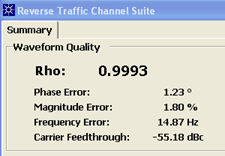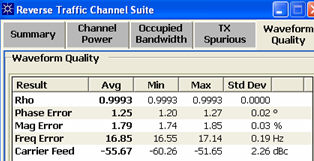
Last Updated: August 29, 2007
This topic describes the Waveform Quality measurement for IS-95 signals. Waveform Quality is a measurement in the Reverse Traffic Channel (RTCH) Measurement Suite.
Waveform quality is the basic measure of the performance of a CDMA transmitter.
A waveform quality measurement is made by sampling the down-converted IS-95 input signal, then applying DSP (Digital Signal Processing) techniques to determine the original data input to the wireless devices transmitter's Walsh spreading function. The DSP then generates a representation of what the "ideal" signal would be given the coding and data in use at the time of transmission. The ideal waveform is then compared with the waveform being measured to determine the waveform quality.
Waveform Quality is a measurement in the Reverse Traffic Channel measurement suite. See Reverse Traffic Channel Measurement Suite Measurement Parameters for details of the parameters that apply to measurements in the suite.
The figures below show the Waveform Quality measurement results as shown on the front panel. Which tab is displayed and the order that they are displayed is determined by the settings in the Results Configuration tab for RTCH Setup.


Several measurement results are returned when a waveform quality measurement is performed. These results, described below, are necessary since they represent error mechanisms that cause the waveform to be less than perfect.
This result provides the integrity indicator for the Reverse Traffic Channel measurement suite. Normal indicates that the measurement suite completed successfully without error and the result is accurate. For details of other integrity indicators, see Measurement Integrity Indicator.
SCPI commands: FETCh:CRTChannel:INTegrity?, FETCh:CRTChannel:WQUality:ALL?, FETCh:CRTChannel:WQUality[:PARTial]?
This result provides rho, which is the fraction of signal energy that correlates with a perfect IS-95 signal after the time offset and frequency error have been removed. Rho provides a measure of how well the signal's power distribution matches the ideal power distribution. A value of 1.00 indicates that all of the transmitted power correlates with the ideal transmission code.
SCPI commands: FETCh:CRTChannel:WQUality:RHO:ALL?, FETCh:CRTChannel:WQUality:ALL?, FETCh:CRTChannel:WQUality[:PARTial]?
This result provides the frequency error, which is a measure of how accurately the wireless device is transmitting at its assigned frequency.
SCPI commands: FETCh:CRTChannel:WQUality:FERRor:ALL?, FETCh:CRTChannel:WQUality:ALL?, FETCh:CRTChannel:WQUality[:PARTial]?
This result provides the carrier feedthrough, which is the ratio of the movement away from the origin of the constellation of the transmitted signal to the unit circle magnitude of the constellation, expressed in dBc.
SCPI commands: FETCh:CRTChannel:WQUality:FEEDthrough:ALL?, FETCh:CRTChannel:WQUality:ALL?, FETCh:CRTChannel:WQUality[:PARTial]?
This result provides the Phase Error, which is the root-mean-square sum of the phase components of each of the error vectors included in the Rho calculation, expressed in degrees.
SCPI commands: FETCh:CRTChannel:WQUality:PERRor:ALL?, FETCh:CRTChannel:WQUality:ALL?, FETCh:CRTChannel:WQUality[:PARTial]?
This result provides the Magnitude Error, which is the ratio of the root-mean-square sum of the magnitude components of each of the error vectors included in the Rho calculation to the unit circle magnitude of the signal vector, expressed as a percentage.
SCPI commands: FETCh:CRTChannel:WQUality:MERRor:ALL?, FETCh:CRTChannel:WQUality:ALL?, FETCh:CRTChannel:WQUality[:PARTial]?
Waveform Quality is a measurement in the Reverse Traffic Channel measurement suite. See Reverse Traffic Channel Input Signal Requirements for details of the input signal requirements that apply to all measurements in the suite.